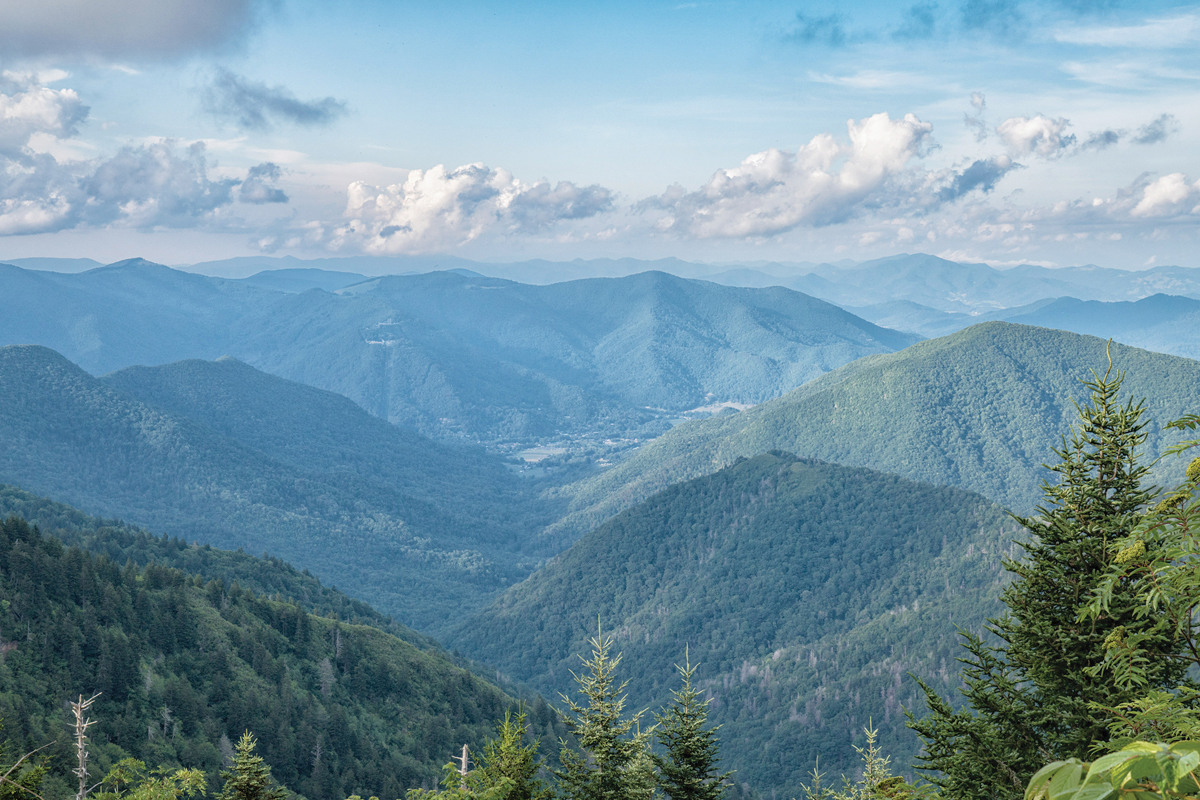Protecting the headwaters: Additional 1,250 acres conserved in Maggie watershed
 The Campbell Creek and Jonathan Creek watersheds tumble down from the rugged slopes surrounding the Blue Ridge Parkway. Steve Orr photo
The Campbell Creek and Jonathan Creek watersheds tumble down from the rugged slopes surrounding the Blue Ridge Parkway. Steve Orr photo
In 2015, not a single acre of conserved land dotted the landscape between the Blue Ridge Parkway surrounding Soco Gap and the town of Maggie Valley below.
Eight years later, nearly 4,000 acres of this rugged mountain land are permanently protected — including 1,250 newly conserved acres in the town watershed.
“You know the tortoise and the hare?” Neil Carpenter, former director of the Maggie Valley Sanitary District, said during a Sept. 29 celebration of the conservation milestone. “Slow and steady wins the race. We won the race here today, guys. Slow and steady. Twenty years, slow and steady.”
Two decades ago, amid discussions within the Maggie Valley Sanitary District Board about the need to protect the land town residents depend on for drinking water, Junior Ward, a lifelong friend of Carpenter’s who at the time worked for the N.C. Forest Service, found out about something called the Forest Legacy Program . A conservation program administered by the U.S. Forest Service in partnership with state agencies, the FLP aims to encourage protection of privately owned forest through conservation easements or land purchases. Ward — who is now the MVSD’s land management specialist — and then Carpenter, thought the program might be their best shot yet to get grant dollars for watershed protection.

Related Items
The plan worked — but only after years of applications that came back empty. Today, 51% of the Campbell Creek Watershed and 31% of the Jonathan Creek Watershed, which both supply the town’s drinking water, have been conserved using more than $8 million in FLP funding. The 2,017-acre William H. Silver Game Land, conserved in 2018 , falls within the Jonathan Creek Watershed, while the Maggie Valley Sanitary District now owns an additional 1,955 acres — of which the first 710 acres was conserved in 2019 — spanning both watersheds.
The Sept. 29 celebration marking protection of an additional 1,250 acres drew a roomful of elected officials, representatives from state and federal land management agencies, and conservation leaders. Sen. Thom Tillis, Sen. Ted Budd and Rep. Chuck Edwards (R-Hendersonville) all sent representatives to read letters praising the conservation efforts in Maggie Valley.
“Western North Carolina’s clean water, forests and public lands are critical for the wellbeing and quality of life and economic prosperity of our mountains,” Edwards wrote in a letter read by his field representative Lake Silver. “Your efforts will help maintain the natural beauty of Maggie Valley and the health of our community for years to come.”
Stewarding a headwaters county
Haywood is a headwaters county, meaning that all the water flowing through the county originates within its borders. This gives towns like Maggie an opportunity to offer residents incredibly clean drinking water — and a responsibility to keep it pristine for those living downstream.
“The Rocky Mountains are the only thing that compares to the water we have here,” said Haywood Commission Chairman Kevin Ensley, who also acted as land surveyor on the project. “And we’re being good stewards by making sure that we preserve that. I think in the future, when future generations look back at this time, they’re going to say, ‘They were very wise in what they did,’ because water in the future will be a very precious resource.”
Unsustainable pressure on existing aquifers and shifting weather patterns related to climate change are predicted to lead to an increase in water shortages in future decades. Even in many places where the water supply remains steady, pollution from emerging contaminants like PFAS is a concern.
But Maggie Valley’s water supply remains among the best in the country. This year, the Maggie Valley Sanitary District won the “Best Tasting Water” award from the N.C. Rural Water Association and will go on to compete in the national competition in February. The organization is among a small number of North Carolina water treatment facilities that have surpassed federal and state drinking water standards for more than 10 consecutive years.
“It’s because of projects like this, preserving that land, that we have pristine water,” said Jason Herbert, current manager for the MVSD. “It makes it a lot easier to treat at the treatment plant, to get it out there and to give our customers the best drinking water that they can have.”
A living project
The conservation milestone is about more than clean drinking water for people. The land abuts the Blue Ridge Parkway and Great Smoky Mountains National Park, connecting to a network of conserved lands totaling hundreds of thousands of acres.
“While these acres are hard at work protecting water quality, they’re also protecting natural communities, wildlife habitat, keeping trout streams cool and clean and providing recreational opportunities as well,” said Will Summer, director of the N.C. Land and Water Fund, which also supported the project.
The newly conserved land ranges from 3,000 to 6,000 feet in elevation, Ward said, offering a gradient of spruce-fir forest, heath balds, rocky outcrops and hardwood forest. It’s home to a variety of wildlife — bear, deer, elk, turkey, northern flying squirrels, songbirds.
“The upper end of the watershed is probably a true wilderness,” Ward said. “It’s never been harvested, no agriculture or anything, because it’s so steep and rugged.”
It also hasn’t been used for recreation — but that could soon change. The boundaries of the portion conserved in 2019 didn’t touch anywhere allowing easy public access. Even MVSD employees had to secure permission to cross private land and access the property. But the newly conserved portion offers better opportunities for public access, and even the possibility of tying into existing trails on Blue Ridge Parkway land. Soon, the MVSD aims to start a master planning process to determine how, when and whether to allow outdoor recreation on the property.
“This is still a living project, so we’ve got some puzzle pieces to get in place,” Carpenter said.
The puzzle itself is likely to grow as the years go by. Ward said he continues to talk to landowners who may be willing to sell their property for conservation.
“This is not the end,” he said. “There will be another phase.”
Celebrating the partnership
These conservation efforts went well beyond the MVSD boardroom.
In addition to the Forest Legacy Program and N.C. Land and Water Fund, the newly conserved acres were made possible with funding from the Stanback family — both the Brad and Shelli Stanback and the Fred and Alice Stanback families contributed — the Pigeon River Fund and individual landowners, all of whom sold their land for less than they would have received on the open market.
“I think it’s important to celebrate the conservation, but I think it’s really important to celebrate the partnership that made the conservation happen,” said Bill Holman, who until recently served as North Carolina director for The Conservation Fund.
Holman and his organization were a key part of that partnership, working over a period of years to identify funding and bring together partners to move the project forward. The Conservation Fund was the driving force behind not only the 710 acres that passed into MVSD ownership in 2019, but also such critical projects as the acquisition of 5,329 acres surrounding Waterrock Knob for transfer to the Blue Ridge Parkway and 912 acres of undeveloped high-elevation land adjoining Sylva’s Pinnacle Park.
Someday, Holman hopes to see a continuous thread of conserved land connecting all the way from Sylva up to the Blue Ridge Parkway and back down to Maggie Valley. This most recent conservation victory was a key milestone toward that goal.
“I’ve been in the conservation field about 40 years and worked on a lot of what I thought were complicated projects,” Holman said. “This may have been the most complicated one.”
The 710 acres protected in 2019 involved five or six individual tracts of land, said Kirk Kirkpatrick, who is legal counsel for the MVSD and served as closing attorney for the 1,250 acres. This more recent project involved 120 parcels of property, some of which were encumbered by deed restrictions.
“It was a real challenge,” he said. “But it’s also very rewarding to do this and do this for a county that my family has been part of since 1780. To protect this for future generations is just really amazing.”









